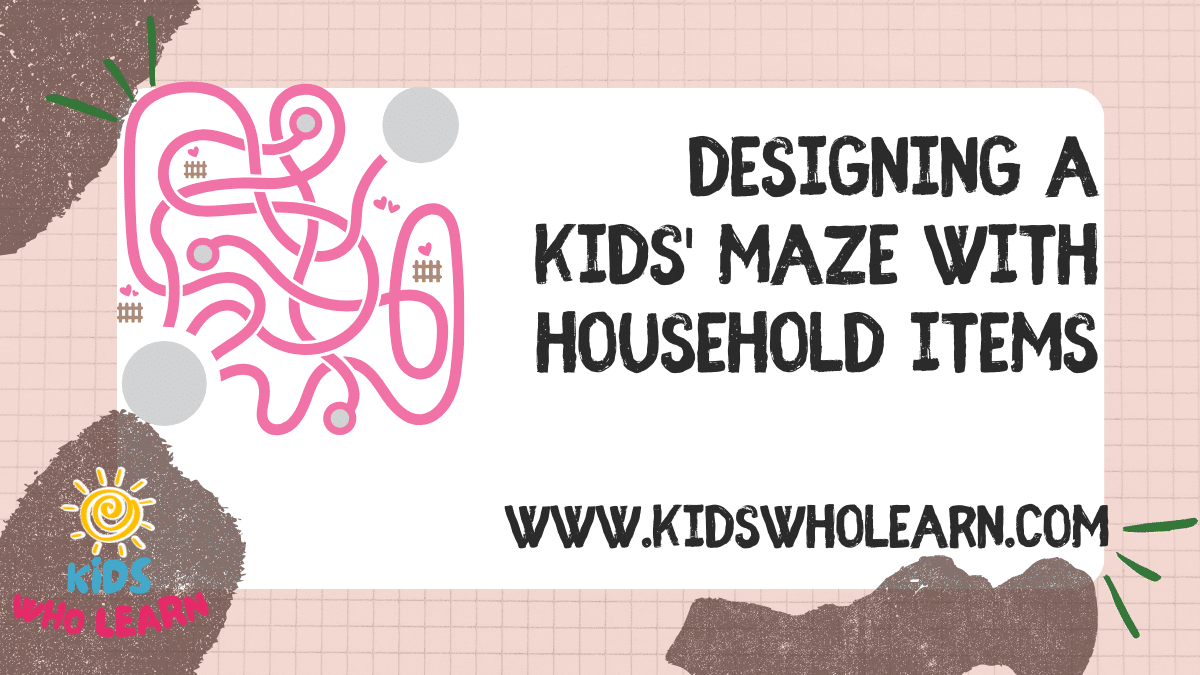Creating a maze for kids using household items is a fun and engaging activity that can be accomplished with ease and creativity. By transforming everyday objects into the building blocks of an adventure, you nourish a child’s imagination and problem-solving skills. A well-designed maze can provide hours of entertainment while also serving as an educational tool that challenges a child’s spatial awareness and cognitive abilities.
To begin, you’ll need to understand the basic principles of maze design, which entail planning clear pathways and dead ends to make the puzzle intriguing yet solvable. Next, you will gather materials you already have at home, such as cardboard boxes, pillows, books, or furniture, that can act as walls or barriers in your maze. The design process starts with a simple layout on paper, gradually transitioning into a full-scale construct, ensuring that the path is safe and sized appropriately for the children who will be navigating it.
The process of building your maze offers an excellent opportunity to integrate educational elements, like simple math or story-telling, into the play experience. Don’t forget to test the maze with your kids, making adjustments and improvements to enhance the fun. Also, adding decorative touches can make the maze more visually appealing and engaging for young explorers. This tangible, interactive project brings learning to life through play.
Key Takeaways
- Constructing a maze with household items promotes creativity and problem-solving for kids.
- A successful maze design involves understanding basic layout principles, safety, and appropriate scaling.
- Educational elements and iterative adjustments enhance the maze’s play and learning value.
Understanding the Basics of Maze Design
Before creating a maze with household items for children, it’s important to understand that a well-designed maze encourages problem-solving and cognitive development. A maze should balance playfulness with challenge, incorporating elements of design and structure that are fundamental to its effectiveness.
The Role of Mazes in Child Development
Mazes are a tangible way to foster several key aspects of growth in children. Through navigating a maze, your child engages in problem-solving and critical thinking. These activities contribute to their STEM (Science, Technology, Engineering, Mathematics) learning by introducing basic principles of logic and order. Mazes can also contribute to STEAM education, which includes the arts, by encouraging creativity in maze design and use. The process of finding a path from start to goal further develops their understanding of beginning and completion sequences in a playful context.
Essential Components of a Maze
Creating an effective maze for children involves incorporating a few essential components:
- Walls and Obstacles: The core feature of any maze. Use household items to build the walls, lining them up to create a complex pathway. Be mindful of the height and stability for safety.
- Clear Start and End Points: Mark the start and goal clearly. This provides orientation and sets a clear objective for the child.
- Challenges: Incorporate various problems like dead ends and simple puzzles within the maze. These should be age-appropriate and encourage children to engage in trial and error.
- Paths and Decisions: Ensuring there are multiple choices to make within the maze improves the complexity and enhances problem-solving skills. However, ensure that the maze is solvable and not too frustrating for the child’s age and skill level.
Remember to keep safety in mind and use non-hazardous materials that are suitable for children. The right balance of these elements contributes to an engaging play experience that supports developmental milestones.
Gathering Materials
When planning to create a maze for kids using household items, focus on selecting items that are versatile and safe. Ensuring that these materials are sustainable will contribute to an eco-friendly activity.
Selecting Household Items for Your Maze
Begin by collecting cardboard pieces, which are an essential for the structure of your maze walls. Old boxes can be transformed into maze partitions with a few cuts. Gather a variety of tape—duct tape for strength and painter’s tape for easy removal—which will be utilized to hold the structure together. Craft supplies such as string, glue sticks or a glue gun, and construction paper can be used for decorative elements. Straws and paper plates serve as additional materials that can add complexity and theming to your maze design. Keep a pair of scissors nearby for cutting materials to the right size.
| Needed Items | Purpose |
|---|---|
| Cardboard | Structure of walls |
| Tape (multiple types) | Assembly and connection |
| Craft Supplies | Decorative elements |
| Straws & Paper Plates | Design details |
| Scissors | Cutting materials |
| Glue (sticks or gun) | Adhesion |
| Construction Paper | Creative enhancements |
Sustainability and Safety Considerations
Prioritize safety by ensuring all materials are non-toxic and free of sharp edges. If children are helping with the construction, safety scissors can be used to mitigate risk. Emphasize recycling by using materials you already have at home, which also teaches children about sustainability. Glue should be used with care, selecting sticks for simplicity or a glue gun for bonding sturdier elements, ensuring that an adult supervises when the latter is in use. String can be repurposed from previous projects, and remember to opt for tape that’s easy to remove without damaging surfaces, emphasizing the responsible use of supplies.
- Safety First: Choose scissors and adhesives that are child-friendly.
- Reuse: Prioritize items that can be recycled or reused.
- Supervision: Adults should manage the use of certain adhesives and cutting tools.
- Non-toxic: Only include materials that are safe for children to handle.
Design Process and Layout
Embarking on the journey of designing a kids’ maze with household items, you must first conceptualize the design, and then physically construct your vision, ensuring both creativity and safe engineering practices are met.
Sketching Your Design on Paper
Begin by sketching the maze on paper. Jot down the start and goal points, ensuring a clear path is mapped out. Your design should incorporate walls, which can be drawn as simple lines, and you may add obstacles at various points for added challenge. Use a pencil to make adjustments easily. The goal is to create a balance between challenge and fun. Below is a sample sketch template:
1. Start Point: [Entrance]
2. Goal/End Point: [Finish]
3. Walls: ______ | ______ | ______
4. Obstacles: [Type] at [Location]
5. Notes:
- Adjust pathways for age-appropriateness.
- Incorporate elements from a favorite story or book.
Remember, the story or theme weaved into your design breathes life into the maze, sparking children’s imaginations.
Building Structures and Pathways
Once the sketch satisfies your vision, begin construction. Erect walls using cardboard box pieces cut to size; they should stand upright and be spaced consistently. Secure them with a glue gun for stability. For the pathways, lay straws in rows to outline the path or use more extended pieces of cardboard.
Here’s a basic materials list to guide you:
- Cardboard: Foundation for walls and pathways.
- Straws: To outline paths or smaller barriers.
- Glue Gun: To bond materials securely.
Keep the structure at a scale appropriate for indoor spaces, and involve children in the building process for an educational experience in construction and engineering, where safety is paramount. Your creativity is the limit, but always adhere to the initial design parameters to maintain structural integrity.
Constructing the Maze
When constructing a kid-friendly maze, precision in assembling the foundation and walls is crucial, as well as creatively incorporating features and thematic elements. Careful selection of household items will transform your space into an engaging labyrinth.
Assembling the Foundation and Walls
First, delineate your maze’s layout using tape to outline the paths on the floor, ensuring you designate areas for dead ends to add complexity. Begin constructing the walls by vertically aligning cardboard boxes as the primary structure, securing them with tape for stability. For finer partitions, straws can be taped together, then attached to either cardboard or heavier base items.
Materials Needed:
- Cardboard boxes
- Tape
- Straws
- Scissors
Instructions:
- Arrange the cardboard boxes to form the maze’s outer structure.
- Use scissors to modify boxes for custom wall lengths.
- Link the straws with tape to create additional barriers.
- Reinforce joined edges with more tape to enhance durability.
Adding Features and Thematic Elements
After setting up the basic structure, embellish your maze with thematic elements. Convert paper plates into signage or decorative objects representative of characters or flowers, affixing them to the walls using glue sticks or a hot glue gun for a sturdier hold. Introduce narrative layers by inserting puzzles or missions, like retrieving a special “flower” or helping a “character” find its way.
Elements to Add:
- Decorative paper plate signs
- Mission-based puzzles
- Thematic props
Decoration Process:
- Designate specific areas for thematic features.
- Decorate paper plates with markers or paint to create characters or flowers.
- Use hot glue gun or glue sticks to attach features to cardboard walls securely.
- Incorporate puzzles as interactive pieces, like a color-matching mission with painted plates.
Educational Integration and Play
Creating a DIY marble maze with household items provides an engaging way for kids to learn key STEM/STEAM concepts while playing. You can build a maze that challenges children to apply principles of science, math, and engineering to navigate a marble effectively.
Incorporating STEM/STEAM Learning Objectives
Science: Explain gravity, friction, and angles by observing how the marble moves inside the maze. Use discussions to connect the marble’s movement to scientific principles.
Math: Involve measurements and geometry to calculate the paths. You could ask kids to predict the marble’s path using concepts of speed and distance.
Engineering: Offer a variety of materials (like paper straws and cardboard) for maze construction, reinforcing problem-solving as they design their labyrinth.
Technology: If possible, include apps or software that track the marble’s path, enhancing kids’ understanding of how technology aids in analyzing real-world data.
Art: Encourage creativity in the maze design, linking art with engineering.
Creating Fun Challenges and Missions
Challenges:
- Time-based: How fast can you navigate the marble through the maze?
- Precision: Can you get the marble to pass through specific narrow paths using tilt control?
- Complexity: Encourage creating multiple layers or sections that add difficulty.
Missions:
- Rescue Mission: Place a small toy inside and design a ‘rescue route’ for the marble to reach it.
- Puzzle Solve: Design the maze with certain ‘keys’ (small blocks) that need to be hit in sequence to ‘unlock’ the end point.
Incorporating these educational aspects into maze gameplay can significantly improve problem-solving skills and make science a tangible and enjoyable experience for kids. Using common household items to create a DIY marble maze makes science, technology, engineering, arts, and mathematics interactive and fun, fostering a hands-on learning environment inside the classroom or at home.
Testing and Iteration
Creating an enjoyable and functional maze for kids requires careful testing and refining to ensure that the problems are solvable and the design is engaging. These steps help you improve the maze and tailor it to the children’s abilities and enjoyment.
Trial Runs and Problem Solving
When you conduct trial runs, you’ll identify sections where kids might get frustrated or lose interest. Use simple items like marbles to test the puzzle’s pathways. If a marble consistently gets stuck, it hints at a design flaw that needs adjusting. Keep in mind:
- Identify areas where participants seem confused or stuck.
- Adjust pathways or puzzle elements accordingly.
Iterative Design and Feedback Loops
The process of designing a maze should be iterative, meaning you’ll make continuous improvements based on feedback. Create a simple feedback loop:
- Test the maze with a small group of children.
- Collect their feedback on various aspects of the maze.
- Implement changes to improve the design.
- Repeat the process.
This cycle ensures your maze remains engaging and enjoyable, as well as age-appropriate. Remember, the goal is steady improvement, not perfection on the first try.
Finishing Touches and Decoration
Once your kids’ maze structure is up and running, it’s time to add some personality and interactive features to increase the fun. Engage your child’s creativity and incorporate elements from their favorite storybooks to make the maze truly one-of-a-kind.
Customizing with Art and Craft Supplies
Start by gathering art and craft supplies such as construction paper, glue sticks, and colorful beads. With these, you can create themed decorations that reflect elements from popular storybooks. For instance, if your child loves a particular storybook character, you could create figures or scenes from that book using construction paper cut-outs attached to the walls of the maze.
- Materials to consider:
- Construction paper
- Glue sticks
- Beads and sequins
- Stickers representing storybook characters
- Markers and crayons
Consider making interactive decorations as well. Attachments like doors that open to different sections or flags they can raise when they’ve reached certain checkpoints can add an element of adventure.
Adding Interactive Elements
Enhance the maze with participation from items that challenge your child’s problem-solving skills. Transform sections of the maze into a makeshift pinball machine using rubber bumpers and let the children navigate a marble maze. This encourages not only navigation skills but also coordination and dexterity.
- Interactive features to add:
- Bumpers from rubber balls cut in half and glued to the floor
- Simple doors created from cardboard that can swing open or closed
- Areas where children must use a marble to continue, simulating a pinball machine
By incorporating these personalized and interactive elements, the maze will not only provide entertainment but also a sense of achievement and lasting memories for your children.
Frequently Asked Questions
In this section, you’ll find direct answers to common questions about setting up a child-friendly maze with items from around your home, catering to various ages and interests.
What are some creative ways to construct a child-friendly maze using cardboard?
You can cut large cardboard boxes to create walls for your maze, and tape them together to form corridors. Decorating the cardboard with colorful paper or paint can make the maze more visually appealing for children.
How can I turn my backyard into an exciting maze for children?
Use outdoor objects such as chairs, tables, and large plant pots to outline the path of the maze. Hanging sheets or blankets between trees or on clotheslines can add height to the maze walls.
What household items can be repurposed to create an engaging maze for kids?
Items like pillows, cushions, laundry baskets, and hula hoops can be laid out to mark the boundaries of your indoor maze. For toddlers especially, soft items ensure safety while navigating the maze.
Can you provide some tips for designing both easy and challenging mazes suitable for different age groups?
For younger children, create wide paths and fewer dead ends in the maze. For older children, add complexity with more turns and dead ends. Introducing simple puzzles or clues can make the maze more challenging.
How do you create a durable marble maze for children using cardboard?
Reinforce the cardboard with duct tape for stability, and use straws or popsicle sticks to create the paths for the marbles. Elevate certain parts of the maze to allow gravity to help the marble move along.
What are some simple steps to build a budget-friendly maze at home for kids’ play?
Sketch out a design for your maze on paper before building. Use readily available materials like rope, tape, or chalk for layout, and repurpose household items as obstacles. Keep the design simple for fun and cost-effective play.












